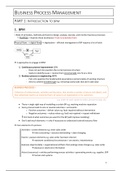Resume
Summary Business Process Management (KUL)
- Établissement
- Katholieke Universiteit Leuven (KU Leuven)
Comprehensive summary of the course Business Process Management (Part of Business Analysis) taught by Professor Jochen De Weerdt at the Catholic University of Leuven. This document includes all course materials to be known for the exam. More specifically, notes from the classes, the slides, and the...
[Montrer plus]





